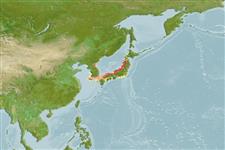Chondrostei (sturgeons) >
Acipenseriformes (Sturgeons and paddlefishes) >
Acipenseridae (Sturgeons) > Acipenserinae
Etymology: Acipenser: Latin, acipenser = sturgeon, 1853 (Ref. 45335).
Eponymy: ‘Mikado’ is a (now obsolete) term for the Emperor of Japan. [...] (Ref. 128868), visit book page.
More on author: Hilgendorf.
Environment: milieu / climate zone / depth range / distribution range
Ecology
Marine; freshwater; brackish; demersal; anadromous (Ref. 51243). Temperate; 56°N - 33°N, 125°E - 145°E (Ref. 54262)
Northwest Pacific: Bering Sea, Tumnin (Datta) river, to northern Japan and Korea. This species was formerly regarded to be a population of Acipenser medirostris (Ref. 6866).
Size / Weight / Age
Maturity: Lm ? range ? - ? cm
Max length : 150 cm TL male/unsexed; (Ref. 12218)
Commercially cultured in Japan (Ref. 6866). From April to May adults feed in fresh water and return to the ocean during the fall (Ref. 12218). Generation time: 15 years (Ref. 116373).
Life cycle and mating behavior
Maturity | Reproduction | Spawning | Eggs | Fecundity | Larvae
Eggs are laid from April to August under the substrate in sandy areas (Ref. 12218).
Birstein, V.J., 1993. Sturgeons and paddlefishes: threatened fishes in need of conservation. Conserv. Biol. 7:773-787. (Ref. 6866)
IUCN Red List Status (Ref. 130435: Version 2024-1)
Threat to humans
Harmless
Human uses
Fisheries: minor commercial; aquaculture: commercial
Tools
Special reports
Download XML
Internet sources
Estimates based on models
Preferred temperature (Ref.
123201): 13.6 - 20.1, mean 18.3 °C (based on 34 cells).
Phylogenetic diversity index (Ref.
82804): PD
50 = 0.5000 [Uniqueness, from 0.5 = low to 2.0 = high].
Bayesian length-weight: a=0.00295 (0.00131 - 0.00665), b=3.18 (3.00 - 3.36), in cm total length, based on LWR estimates for this Genus-body shape (Ref.
93245).
Trophic level (Ref.
69278): 3.3 ±0.3 se; based on size and trophs of closest relatives
Resilience (Ref.
120179): Very Low, minimum population doubling time more than 14 years (Preliminary K or Fecundity.).
Fishing Vulnerability (Ref.
59153): Very high vulnerability (90 of 100).
